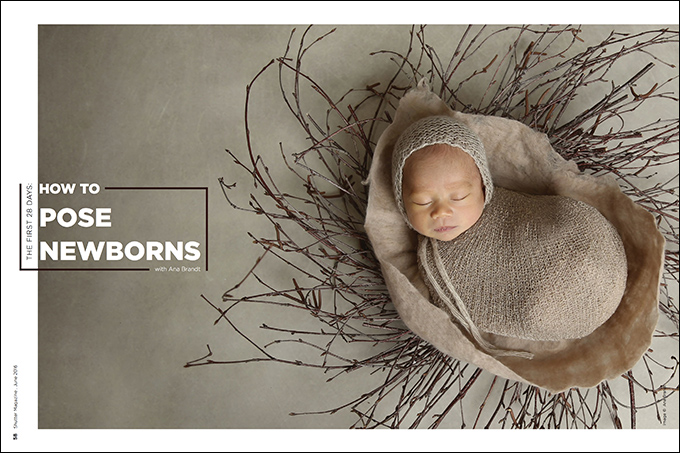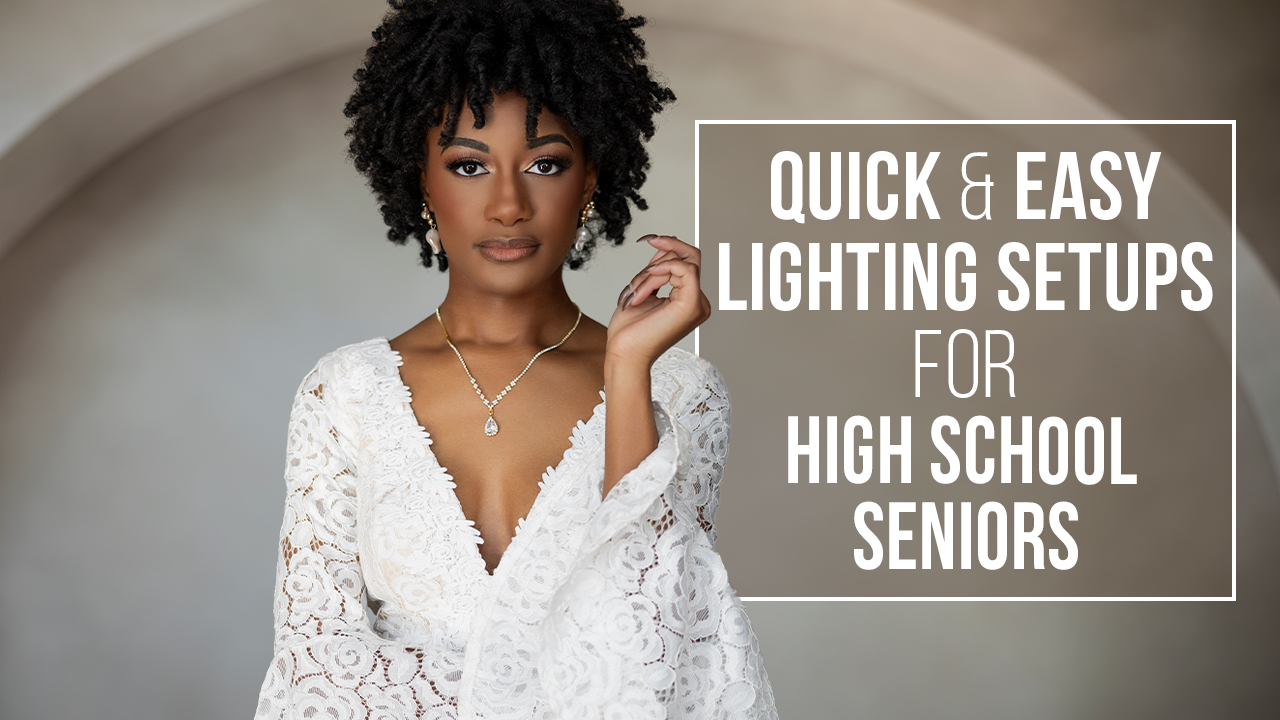The First 28 Days: How to Pose Newborns with Ana Brandt
The newborn stage is defined as the first 28 days of life, after which humans are referred to as infants for up to three months. In our studio, we consider newborns to be as old as six weeks, as most babies are born earlier than the 40-week cycle. A baby is considered premature when it is born at least three weeks before the due date—in other words, before the start of the 37th week.
When I started shooting newborns in 1999, it was common to photograph a newborn anywhere from four to six weeks. Now, most photographers want to shoot them at under two weeks.
Newborns can be photographed during any part of the newborn stages if the photographer is prepared and knows the methods of soothing and caring for the baby. With that being said, there are times where a newborn is not having a very good day and is so fussy that capturing a single image is impossible. A number of factors can explain why, and I do not believe in forcing a session. If a baby cannot be properly soothed and cared for, it’s okay to reschedule with parents.
Parents and photographers always ask me when the perfect time is to photograph a newborn. I find it easiest to shoot babies between 10 and 14 days. I’ve also photographed babies between 15 and 20 days with no issues at all. It is important to find out if Mom wants sleepy-baby photos or awake photos. As they move along in their progression, they will be more awake and alert, but photographing them in this stage is often harder. Keeping a baby wrapped, warm, settled and well fed can reveal some amazing wide-awake images.
Note that brand-new babies may have peely, flaky skin as they shed their first layer. Around two to three weeks, they can develop acne. Trying to create the perfect session between peely skin and acne is a big guessing game, but just the right amount of retouching can cure either.
We suggest that our clients call or leave us a message within 24 to 48 hours of giving birth. If they are scheduled for a C-section, we preschedule their session and then follow up to make sure everything went as planned.
Other factors besides the age of the baby are very important, such as weight. If a client calls me to photograph her baby at one week and her baby is less than six pounds, I often suggest she wait a little longer to make sure the baby is gaining weight and eating well. Whereas if a mother calls me with a 9-pound baby, I may suggest we get that baby in sooner—perhaps around the eighth or ninth day.
Key Factors in Shooting Newborns
Delivery
Was delivery on time and as planned? Was there any trauma to the baby? Injuries? Difficulties with breathing? Jaundice? Circumcision?
Over the years, I have heard about and seen just about everything. From bruised heads, to heart conditions, to painful circumcisions—the list goes on an on. This is an extremely sensitive time for family and baby. Make sure delivery went as planned, and that baby is healthy and Momma is recovering well. If anything has gone wrong and requires home rest or more doctor visits, the newborn session will just have to wait.
I have received too many calls from stressed-out parents who have been told their one-month newborn is too old for a photography session. Who is telling them this? Photographers. Will it be more of a challenge? Maybe. This depends on the expectations of the client and the skill of the photographer. It gets harder and harder to achieve a curled-up newborn in a sleepy womb position each week as the baby grows and the bones develop.
While newborns are very sleepy during the first 14 days of life, they are often wide-awake and alert for longer at 28 or 34 days. Before the session, set parents’ expectations of what poses can be achieved. Photographers should also never “guarantee” any poses at any age. Newborns are human beings—and, while they’re tiny and are unable to say how they are feeling, they will let you know pretty quickly if a pose is uncomfortable. Never force poses, and always make safety your first priority.
Time of day
Newborns are generally best photographed in the morning. They are often up most of the night and then fall into a deep sleep in the early morning. Midday usually works well as long as the baby is fed right before the session. Late afternoon is not ideal, especially for newborns with toddler siblings. An afternoon session can head into the dinner hour, which is often a cranky time for everyone involved. We tell parents that we understand they are exhausted, but if they can come to us first thing in the morning and feed their baby before their session, they can relax for the first hour as we focus on baby. By focusing on the baby first, parents have time to get dressed and have coffee before family pictures begin.
Baby feeding
Newborns generally eat every two to three hours, depending on how well they are latching or handling a bottle. Ask the parents how long their feeding schedule is. The length of their feeding schedule determines how much time I have to work.
If the baby feeds every two to three hours, I suggest that Mom feed baby a full feeding right before the scheduled session. If the session starts at 10:00, then I am hoping for a 9:30 feeding, which means the baby probably has not fed since 7:00 or 7:30. In this example, Mom comes with a baby ready to feed. The baby feeds and then often lets gas out and will have bathroom time, all while being wrapped up and secured.
If I can work well in my newborn session workflow, then I can get through an entire newborn session before the next feeding. This often makes the difference between a two-hour and a four-hour newborn session. Once you go into the next feeding cycle, it delays the session for another 30 to 45 minutes of feeding and soothing, and often extends through the length of time set aside.
Each baby is different. We tell our parents—especially those traveling a long distance—that if their baby is hungry, feed her. Most babies feed on demand and have no real schedule in the first few days of life. Some babies latch really well, and others need to be fed with a syringe. Discuss feeding habits before the session to ensure a smooth shoot.
Heat
Most newborns are swaddled for the first two weeks of life, if not longer. They are kept very warm since the womb in which they were raised was about 99.86 degrees, which is the same as a woman’s body temperature. A baby’s temperature averages around 96.8 degrees. Babies cannot regulate their own temperature since they can’t shiver or sweat. Newborns’ body temperature is regulated by their body fat. This is why a 9-pound baby often does very well naked, while a 6-pound baby won’t settle well if not properly wrapped.
I don’t use heating pads because I can’t regulate how much heat is hitting the baby’s body. Instead, we use portable heaters at a safe distance from the baby to warm the room. We start most newborn sessions with the baby wrapped well, and slowly unwrap her as she adjusts to the room temperature. We then slowly work with various poses as the baby allows. Heavier babies (9 or 10 pounds) often feel very warm, and we don’t keep the wraps on as long for them.
A note on twins
Twins often arrive early and are smaller. Learn their weight and prematurity stage before scheduling. We photograph twins around two to three weeks.
So what are the best poses for each week of those 28 days? See the images below for some ideas.
Newborn Photographer’s Checklist
- Baby shusher/white noise
- Hand sanitizer
- Baby posing beanbags
- Posing beanbag
- Cloth diapers
- Chucks
- Spare diapers
- Spare pacifiers
- Aquaphor
- Wipes
- Heating source
- Weights for props





This Post Has One Comment
Cute picture for the cover, but the lighting is wrong for a portrait of this subject.